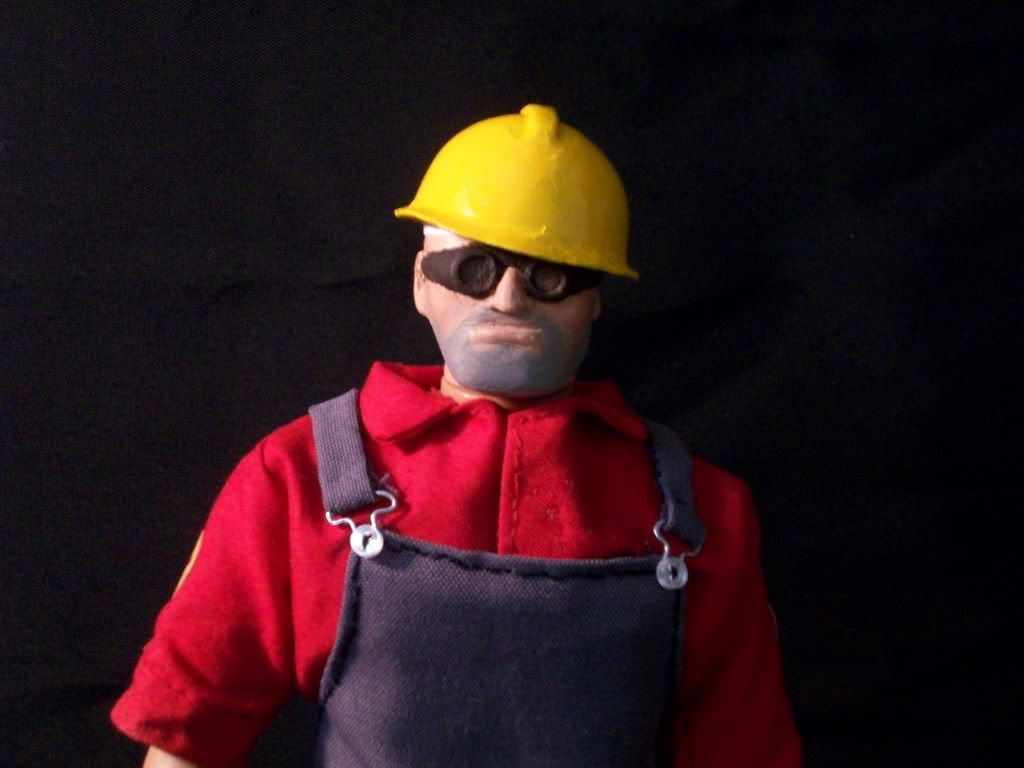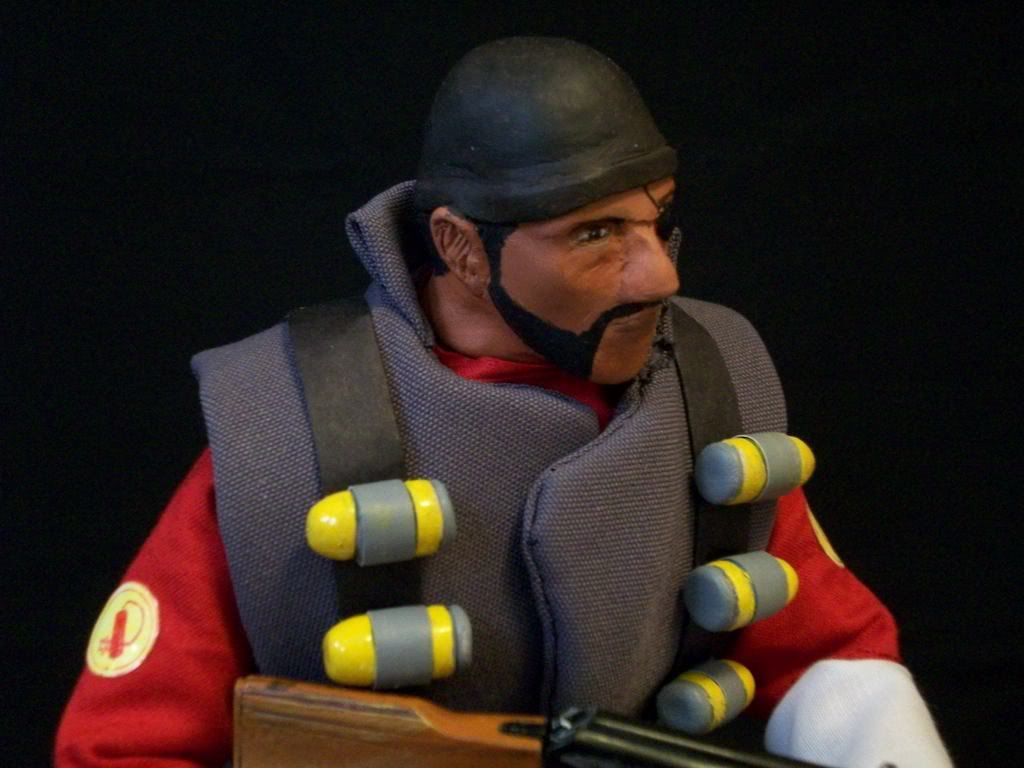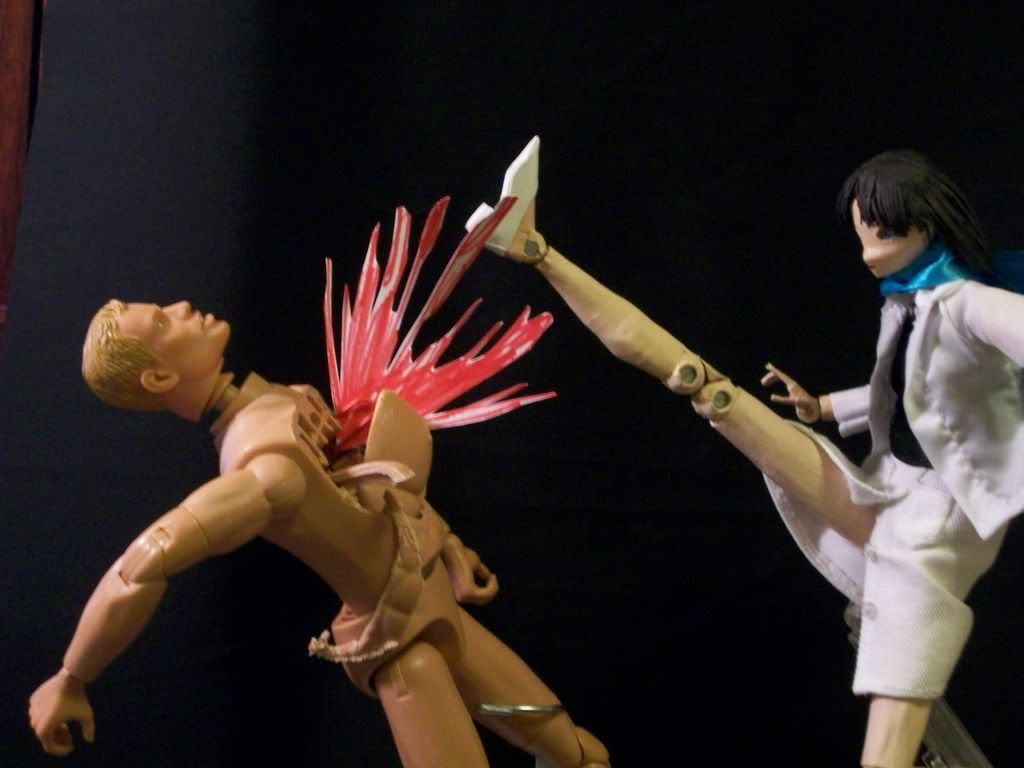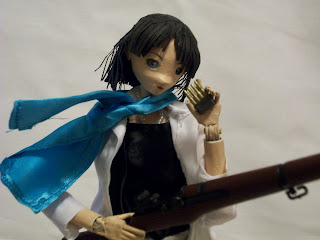I've been practically innundated with a single question on how I sculpt the heads for these Team Fortress 2 figures. Time to shed some light on what goes on during the 2-3 hour span a head sculpt gets done.
As usual, I start off with decapitating a doll. A 110 lb cardstock tube gets molded around the attachment point, serving as the base for the neck.
I put a coating of sculpey around and in the top of the cylinder. Sculpey doesn't stick to anything but sculpey, so I recommend using very lightly kneaded sculpey so it's still solid, or finding some means of making the cylinder sticky like mixing in another clay. On the left of the cylinder, there's a piece that has two prongs coming out the right. What I like to do next is make a jaw, and as you will see, that piece shapes out the side profile of the face.

Using the former head as reference, I place some clay where the nose, eye sockets, eyebrows and ears will go. This helps determine spatially what I need to do. These heads are regular, so these landmarks will be valid for all human heads.
Now for the creepy stalker headshot gallery. Every sculptor needs a good set of views of what they're sculpting. I've added a general set of features to the face, including a line for the mouth and general eye sockets for locational purposes. I tend to play with the shape of the nose now, so I get a feel of where the rest of the facial features lie in relation to it.

Here, I've added subtle depressions and elements to round out the face based on the headshot gallery. The chin, lips and cheekbones are taking shape now. Normally, I'd carve out a faint outline for the eyes, but the Engineer has goggles, making that wasted.
Bit more material and X-acto knife cutting, I reach this stage where the face has 70-80% of the features defined.
Modding a regular soldier helmet to be an engineer hat. Soldier helmets are taller and therefore need some sawing. Now to make the helmet lip and top protrusion.
Overpriced Games Workshop epoxy ($8) is a bit flexible when dry and thinly applied, and sticks well. If not, there's always Loc-tite. The shop guy told me to keep my tools wet so the green stuff doesn't stick on them. I suggest having a cup of water nearby to wet your fingers.
A bit of baking in the oven for 2 hours at 275 degrees Fahrenheit. Note the reddish color. That's a sign of the sculpey being solid. Really good and solid sculpey would look real red, not this half-assed pink I settled for.

After some painting, this is what you get. To do beard stubble, I do a direct layer of grey onto the face, then before it dries, apply a thin portrait tone/flesh color layer on it. Since the over layer is lighter, it doesn't completely cover up the grey, making a lighter, stubbled beard appearance.
However, in the event your head doesn't have goggles or something covering his eyes, you'll have to do some eye painting.
 Jin Saotome has a good tutorial
Jin Saotome has a good tutorial that I half-assed (as usual) to do the Demoman's eye. I did the first half or so, since I'm not too keen on that realistic looking of an eye. Also, I have about the worst brush selection and miniature painting skill for a modeler. For people who aren't rubbish at painting miniatures or have surgeon hands, this will be a bit easier and better looking for you. I think I did the best job so far on the Demoman, since he had only one eye and I tried on that one. The Soldier and Sniper have stuff blocking their eyes, so I had some leeway with cutting corners.
That in essence is the entire sculpting process. Takes at least 2 hours to sculpt, and about 4-5 hours to get to the painting stage. You may take longer, depending on how great your spatial skills and ability to work with small details in clay are.
 Here's a shot of the near completed main barrel for Sasha, the minigun. It's propped up on top of what I presume is the ammo drum. The two smaller rolls are for some inexplicable components that I'll have to sort out soon. The background sketches are the only two images I'm using so far to draft up parts. The rest are from screenshots. Right now, it's looking a bit small. Let's put something in frame to show the scale of the gun.
Here's a shot of the near completed main barrel for Sasha, the minigun. It's propped up on top of what I presume is the ammo drum. The two smaller rolls are for some inexplicable components that I'll have to sort out soon. The background sketches are the only two images I'm using so far to draft up parts. The rest are from screenshots. Right now, it's looking a bit small. Let's put something in frame to show the scale of the gun. Here's a 28cm tall Engineer, with a ruler to illustrate how massive this thing is. Just the spinning barrel assembly is 30 cm long (yes, I allowed for rotation). I would have bothered showing construction progress of the barrel, but it's just rolling up tubes. Tedious work, and not too exciting blog fodder. I'll show some of the components broken down next.
Here's a 28cm tall Engineer, with a ruler to illustrate how massive this thing is. Just the spinning barrel assembly is 30 cm long (yes, I allowed for rotation). I would have bothered showing construction progress of the barrel, but it's just rolling up tubes. Tedious work, and not too exciting blog fodder. I'll show some of the components broken down next. The flashlight shaped object is the barrel spinning mechanism housing. The inconspicuously placed cylinder below the large ammo drum thing is the cap for the six barreled shaft. I currently have a separate, non-glued shaft spacer that's being used to hold the assembly together. Once the model's painted, I'll consider gluing it down.
The flashlight shaped object is the barrel spinning mechanism housing. The inconspicuously placed cylinder below the large ammo drum thing is the cap for the six barreled shaft. I currently have a separate, non-glued shaft spacer that's being used to hold the assembly together. Once the model's painted, I'll consider gluing it down.
















































